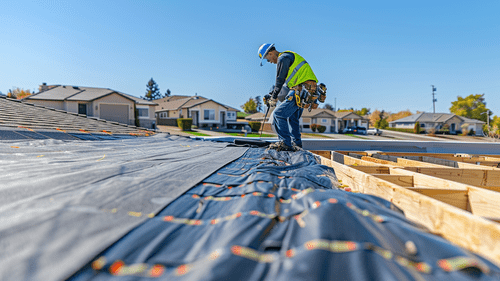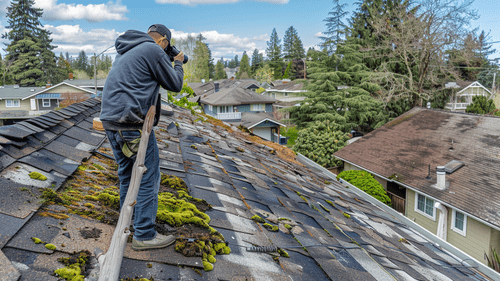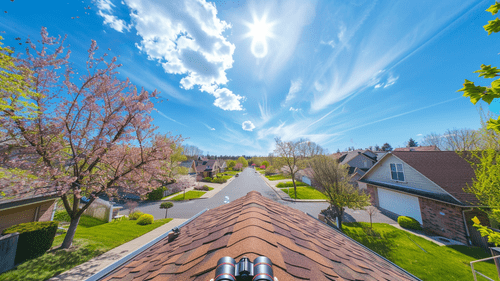Your roof is more than just a protective barrier—it's one of your home's most significant investments. Yet many homeowners unknowingly damage their roofs through improper cleaning techniques, leading to costly repairs and shortened lifespans. What's the real cost of those black streaks or moss patches you've been ignoring? And could your well-intentioned cleaning efforts actually be making things worse?
Proper roof cleaning isn't just about improving curb appeal—it's about protecting your investment for years to come. This guide walks you through safe, effective cleaning methods tailored to your specific roofing material. From gentle cleaning solutions that won't compromise your shingles to the right equipment that removes buildup without causing damage, we've got you covered. By understanding the unique needs of your roof and implementing the right maintenance strategies, you'll avoid common pitfalls while extending your roof's life and performance.
Assessing Your Roof Before Cleaning: The Critical First Step
Before you reach for cleaning supplies or call a professional, taking time to properly assess your roof can save you thousands in potential damage. Different roofing materials—whether asphalt shingles, clay tiles, metal, or slate—each have specific vulnerabilities and cleaning requirements. Asphalt shingles, the most common residential roofing material, can lose their protective granules when subjected to harsh cleaning methods, while clay tiles may crack under excessive pressure.
Begin your assessment by identifying your specific roof type and its age. Newer roofs generally require gentler treatment than older ones, which may have already experienced some deterioration. Using binoculars from ground level can provide a safe initial inspection, allowing you to spot areas of concern without risking roof access. Look specifically for black streaks (indicating algae growth), green patches (moss), or white/gray crusty spots (lichen)—each requiring different treatment approaches.
A thorough inspection should also reveal any existing damage that needs addressing before cleaning begins. Pay particular attention to:
- Cracked, curling, or missing shingles
- Damaged flashing around chimneys, vents, or skylights
- Sagging areas that might indicate structural issues
- Clogged gutters contributing to water backup and roof damage
- Signs of water infiltration in your attic (stains, mold, dampness)
The condition of your roof will dictate your cleaning approach. For instance, homes in heavily wooded areas often face more significant organic debris and moisture retention issues, requiring more frequent but gentler cleaning. Similarly, north-facing roof sections typically experience more algae and moss growth due to reduced sun exposure. Document these problem areas specifically in your assessment to develop a targeted cleaning strategy.
Weather considerations play a crucial role in timing your roof cleaning. Choose a mild, overcast day with little wind—hot sunny days can cause cleaning solutions to dry too quickly before they've had time to work effectively, while rainy conditions create safety hazards and dilute cleaning agents. The ideal cleaning window is typically spring or fall when temperatures are moderate. Avoid cleaning during winter months in colder climates, as freezing temperatures can make roofs particularly vulnerable to damage during the cleaning process.
Gentle Cleaning Solutions That Protect Rather Than Harm
The cleaning solutions you choose can mean the difference between preserving your roof and accelerating its deterioration. Many homeowners make the costly mistake of reaching for chlorine bleach (sodium hypochlorite), believing its powerful stain-removing properties make it ideal for roof cleaning. In reality, chlorine bleach can be devastating to roofing materials—breaking down the binding agents in asphalt shingles, corroding metal fasteners, and killing beneficial microorganisms in your soil when it runs off.
Biodegradable cleaning agents work through different mechanisms that target organic growth without compromising roofing materials. These solutions typically contain surfactants that loosen the bond between biological growth and your roof surface, allowing for gentler removal. The science behind these cleaners involves disrupting the cellular structure of algae, moss, and lichen without the harsh oxidizing effects that damage roofing components. Many professional-grade biodegradable cleaners contain quaternary ammonium compounds that provide longer-lasting protection against regrowth compared to traditional cleaners.
For those preferring DIY approaches, several effective yet roof-friendly solutions can be made at home. A mixture of one cup oxygen bleach (sodium percarbonate) dissolved in two gallons of water provides cleaning power without the damaging effects of chlorine bleach. For persistent moss problems, a solution of one cup white distilled vinegar mixed with one gallon of water can be effective when applied carefully to affected areas. Remember that even these gentler solutions should be tested on a small, inconspicuous area first to ensure compatibility with your specific roofing material.
Understanding pH balance is critical when selecting cleaning agents. Most algae and moss thrive in slightly acidic environments, while lichen prefers alkaline conditions. This is why one-size-fits-all approaches often fail. For asphalt shingles, slightly alkaline cleaners (pH 8-9) typically work best for algae, while slightly acidic solutions (pH 6-6.5) may be more effective against lichen. Metal roofs generally respond well to neutral pH cleaners (pH 7) to prevent corrosion risks. Clay and concrete tiles can typically withstand a wider pH range but still benefit from milder formulations to preserve their color and surface integrity.
Different biological invaders require specialized approaches. Black streaks from Gloeocapsa magma (blue-green algae) respond well to oxygen-based cleaners, while thick moss may require pre-treatment with a zinc sulfate solution to loosen its rhizoids (root-like structures) before gentle removal. Lichen presents the greatest challenge, as its symbiotic nature (part fungus, part algae) creates a particularly tenacious attachment to roofing materials. For lichen, copper-based solutions applied at low concentrations can be effective without damaging most roofing materials, though they should never be used on metal roofs due to galvanic corrosion risks.
Equipment and Techniques for Safe, Effective Cleaning
Selecting appropriate equipment is just as important as choosing the right cleaning solution. The pressure washing equipment commonly found in many garages can be the single greatest threat to your roof's integrity when used improperly. Standard pressure washers typically operate at 2,000-4,000 PSI (pounds per square inch)—far too powerful for most roofing materials. Even asphalt shingles, among the most durable roofing options, should never be cleaned with pressure exceeding 100 PSI. This low-pressure approach, often called "soft washing," relies more on appropriate cleaning agents and dwell time than on forceful water pressure.
Soft washing systems typically combine larger nozzle openings with reduced pump pressure to deliver cleaning solutions gently onto roof surfaces. Professional-grade systems often feature adjustable pressure regulators and specialized roof nozzles designed to distribute solution evenly without concentrated force. For homeowners, an inexpensive garden sprayer can often provide sufficient and safe application of cleaning solutions. The key principle is to apply solutions liberally enough to ensure proper coverage and dwell time, but never with enough force to drive water under shingles or dislodge protective granules.
Specialized tools can make a significant difference in cleaning effectiveness while minimizing damage risks. Long-handled soft-bristle brushes designed specifically for roof cleaning allow for gentle agitation of stubborn growth without abrasive action. When selecting brushes, look for non-metallic, non-abrasive bristles that won't scratch or gouge roofing materials. For moss removal, plastic snow removal tools with rounded edges can gently lift moss mats after treatment with appropriate solutions. Always work in a downward direction on the roof to prevent lifting shingles or tiles, and avoid scrubbing motions that can dislodge protective materials.
Proper application techniques require patience and attention to detail. Begin by thoroughly soaking the roof with plain water, working from bottom to top (contrary to cleaning, which proceeds top to bottom). This pre-wetting prevents the cleaning solution from drying too quickly and ensures more even application. When applying cleaning solutions, maintain consistent coverage without allowing solutions to pool, which can lead to excessive concentration in certain areas. Allow solutions to dwell according to manufacturer recommendations—typically 15-20 minutes—before gentle rinsing with low pressure, always working from top to bottom to prevent solution from flowing under shingles.
Safety considerations cannot be overstated when working on roofs. Beyond the obvious fall risks, chemical exposure and ladder safety require specific precautions. Always wear non-slip footwear, eye protection, chemical-resistant gloves, and respiratory protection when applying cleaning solutions. Secure ladders properly using stabilizers and have a spotter when possible. Consider using a safety harness system anchored to a secure point for steep roofs. Remember that a wet roof becomes significantly more slippery, increasing fall hazards substantially. For roofs with pitches exceeding 6/12 (26.5 degrees), professional cleaning services with proper safety equipment are strongly recommended rather than DIY approaches.
Preventing Future Damage: Proactive Maintenance Strategies
Implementing preventative measures can significantly extend the time between cleanings while protecting your roof from biological growth. One of the most effective long-term solutions involves installing zinc or copper strips along the roof ridge. When rainwater flows over these metals, it creates a natural biocide that inhibits algae, moss, and lichen growth. Zinc strips are more affordable but less effective than copper, which can provide protection for up to 15-20 years. For optimal coverage, install strips just below the ridge cap on each roof plane, ensuring at least 2-3 inches of metal remains exposed to rainfall.
The effectiveness of metal strips varies based on your local climate and roof configuration. In areas with frequent rainfall, these strips provide more consistent protection as the metal ions are regularly distributed across the roof surface. However, in regions with concentrated heavy downpours followed by long dry periods, supplemental treatments may still be necessary. For maximum effectiveness, additional strips may be needed every 15-20 feet down the roof plane on larger homes, particularly those with complex roof designs that create areas sheltered from metal-treated runoff.
Creating a regular inspection and cleaning schedule tailored to your specific environment prevents minor issues from developing into major problems. Homes in humid, heavily wooded areas typically require roof inspections at least twice annually—once in late spring after pollen season and again in late fall after leaf drop. During these inspections, remove any accumulated debris, check for early signs of biological growth, and ensure gutters and downspouts remain clear. Simply removing debris regularly can significantly reduce moisture retention that leads to algae and moss establishment.
The relationship between gutter maintenance and roof health is often overlooked yet critically important. Clogged gutters create backed-up water that can seep under shingles and create ideal conditions for biological growth. Beyond regular clearing, consider installing gutter guards appropriate for your local conditions—micro-mesh systems work well in areas with small debris like pine needles, while larger-opening guards may be sufficient for primarily leaf debris. Ensure downspouts direct water at least 5-10 feet away from your foundation to prevent moisture from affecting your entire home system.
Early intervention techniques can address potential problems before they require intensive cleaning. For minor algae spots just beginning to appear, targeted application of appropriate cleaning solutions to specific areas can prevent spread without requiring whole-roof treatment. Similarly, individual moss patches can be treated with zinc sulfate solution (1-2 ounces per gallon of water) applied directly to affected areas. Regular trimming of overhanging branches not only reduces debris but also increases sunlight exposure, naturally inhibiting moss and algae growth through UV exposure and improved drying after rainfall.
Preventative treatments applied during optimal weather conditions can extend protection between major cleanings. Professional-grade preventative sprays containing zinc or copper compounds provide a protective barrier that inhibits new growth establishment. These treatments are most effective when applied to a clean, dry roof on a day with no rain forecast for at least 24 hours. For DIY approaches, solutions containing copper sulfate pentahydrate (1-2 ounces per gallon of water) can provide similar protection when applied carefully, though care must be taken to avoid metal components and excessive runoff that might affect landscaping.
When to Call the Professionals: Recognizing Your Limitations
Despite the best DIY intentions, certain roof cleaning scenarios demand professional expertise. Complex roof configurations with multiple pitches, dormers, skylights, or solar panels create significant safety challenges and require specialized equipment to clean effectively without damage. Similarly, roofs with extensive biological growth—particularly thick lichen colonies or widespread moss covering more than 25% of the surface—generally require professional-grade solutions and application techniques. Historic homes with slate, clay tiles, or wood shake roofs almost always warrant professional cleaning due to the specialized knowledge required for these vulnerable materials.
Conducting a realistic cost-benefit analysis helps determine when professional services make more sense than DIY approaches. Consider not just the immediate costs of cleaning supplies and equipment rental, but also the potential long-term costs of improper cleaning. Professional services typically range from $0.20-$0.70 per square foot depending on roof complexity, material, and growth severity. While this may seem significant compared to DIY supply costs, professional cleaning often provides more thorough results with substantially lower risk of damage that could lead to premature roof replacement—a far more expensive proposition averaging $8,000-$20,000 for most homes.
When selecting a roof cleaning professional, credentials and methodology matter more than price. Look for companies with proper insurance specifically covering roof work (general liability and workers' compensation), manufacturer certifications for your specific roofing material, and membership in professional organizations like the Roof Cleaning Institute of America. Request detailed information about their cleaning process—reputable companies will readily explain their methods, solutions, and equipment without vague references to "proprietary" techniques that cannot be disclosed.
During the interview process with potential service providers, specific questions can reveal their expertise and commitment to roof protection. Ask about their pressure settings for your specific roof type, the exact cleaning agents they use (including pH levels and biodegradability), and their prevention strategies against solution runoff that might damage landscaping. Request information about their rinse procedures—thorough rinsing prevents cleaning solution residue that can attract dirt and lead to premature regrowth. Finally, inquire about their policy for addressing any damage that might occur during the cleaning process.
Understanding the value of professional warranties provides additional protection for your investment. Quality roof cleaning companies typically offer guarantees against regrowth for specific periods—usually 1-3 years depending on local conditions and the treatments applied. These warranties should be in writing and clearly specify what constitutes covered regrowth versus new contamination. Some companies also provide documented before-and-after photos as part of their service, creating a valuable record for warranty purposes and for monitoring roof conditions over time. When comparing service providers, consider the warranty terms as part of the overall value proposition rather than focusing solely on the immediate service price.
Conclusion: Protecting Your Investment Through Proper Roof Care
Your roof deserves more than haphazard cleaning attempts that risk causing more harm than good. Through proper assessment, gentle cleaning solutions, appropriate equipment, and preventative maintenance, you're not just removing unsightly stains—you're extending your roof's lifespan and protecting your home's structural integrity. Whether you choose the DIY route with biodegradable solutions and soft washing techniques or invest in professional services with proper credentials and warranties, the key lies in understanding your specific roofing material's needs and vulnerabilities.
Remember that those black streaks and moss patches aren't merely cosmetic concerns—they're early warning signs of potential damage that, if left untreated, can lead to thousands in unnecessary repairs. The most effective approach combines timely intervention with regular preventative measures like zinc strips, proper gutter maintenance, and scheduled inspections. Your roof silently protects everything beneath it every day—isn't it time you returned the favor with care that preserves rather than damages this critical investment?







